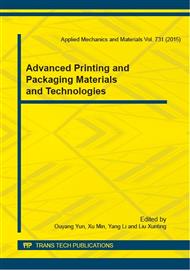p.502
p.506
p.510
p.515
p.520
p.524
p.528
p.535
p.541
Effects of Tackifiers on the Properties of one Component Polyurethane Adhesive
Abstract:
Polyurethane adhesive is containing isocyanate and urethane groups in the molecular bonds, a kind of adhesive has high polarity and lively type. By adjusting the raw materials and formulations can be perpared to meet the requirement of the raw product between different materials bonding. In this paper, the experiments used poly-1,4-butylene adipate glycol (PBA) as soft segment materials and 4, 4’-diphenylmethane diisocyanate as hard segment materials, and used 1,4-butylene glycol as chain extender. What’s more, the experiment adopt rosin resin, phenylethylene and petroleum resin as polyurethane tackifier, we can composed to polyurethane polymers in certain conditions. By changing the type and amount of tackifier ,we can get different polymers, after that from initial strength, final strength, softening temperature and melt viscosity do a comparative experiment with the polyurethane hot melt adhesive of books binding. The results show that proper selection and addition of petroleum resin can meet the requirement of bond property of polyurethane hot melt adhesive which used in books binding, and it has the advantages of low cost ,energy conservation and environmental protection ,which makes it has a good application prospect.
Info:
Periodical:
Pages:
520-523
Citation:
Online since:
January 2015
Authors:
Keywords:
Price:
Сopyright:
© 2015 Trans Tech Publications Ltd. All Rights Reserved
Share:
Citation:


